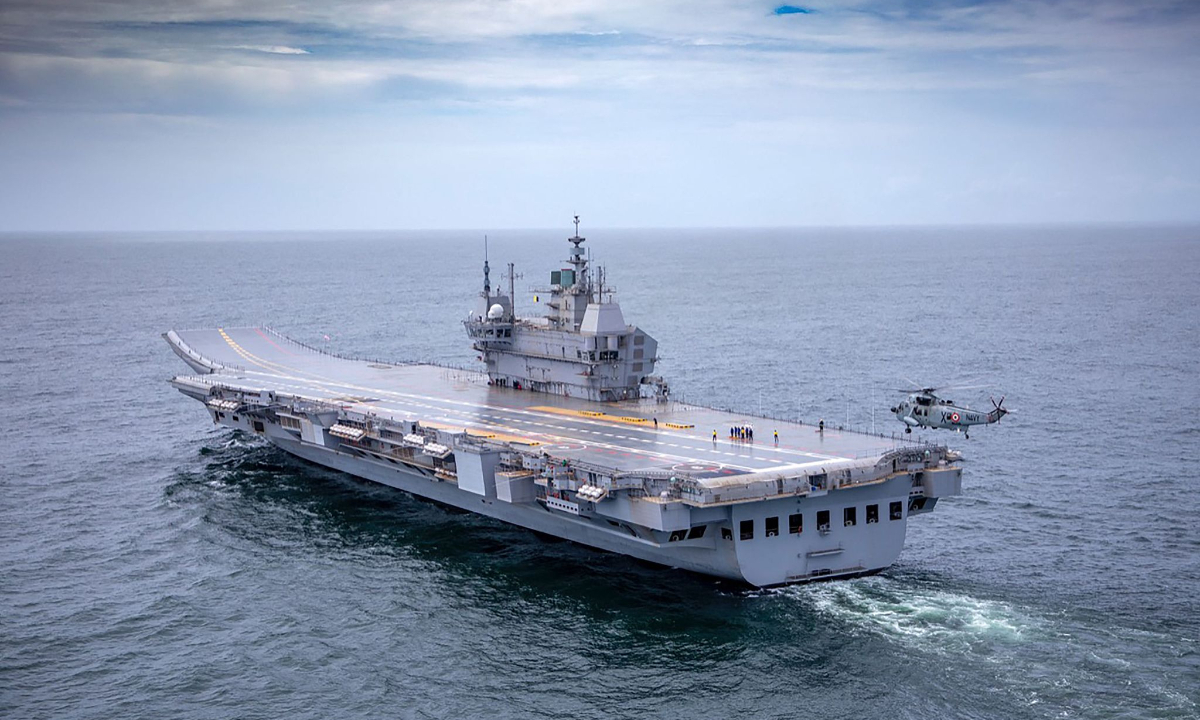
The Vikrant, India's first indigenous aircraft carrier Photo:VCG
After over a decade of construction, India's first indigenous aircraft carrier, the
Vikrant, was handed over to the Indian navy by its constructor, Cochin Shipyard, on Thursday. Chinese experts said on Friday that although there is still a big gap between the
Vikrant and China's third aircraft carrier
Fujian, which was launched in June, India's long and arduous road to producing the
Vikrant shows New Delhi's ambition and determination to become a maritime power.
According to the Indian media, the aircraft carrier is 262 meters long, with a full displacement of close to 45,000 tons and a maximum speed of 28 knots.
With an indigenous content of 76 percent, the carrier cost about $3.13 billion, Indian media reports said. Citing an Indian Navy spokesperson, Indian media reports said the delivery of the ship signals that India has joined the club of nations that have the capability to design and build aircraft carriers independently.
The design of the aircraft carrier began in 1999 and the keel was laid a decade later in 2009. It then took over 12 years before the start of sea trials in August 2021, and the final delivery in July 2022 according to Indian media reports.
During the long period of time from 1999 to 2022, China made a breakthrough by launching three aircraft carriers. India's slow pace in building its first indigenous aircraft carrier shows the difficulty of the process. China and India's indigenous development of aircraft carriers started from the same place - the former Soviet Union.
The design of the
Vikrant is based on
Vikramaditya, the former Soviet Union's second-generation carrier. The Chinese Type 001 aircraft carrier
Liaoning is a refurbished and upgraded version of the
Varyag, a third-generation Soviet carrier.
Chinese military expert Song Zhongping told the Global Times on Friday that the
Liaoning is a large carrier while the
Vikrant is only a medium-size carrier. In addition, the
Liaoning has stronger carrier-based aircraft capabilities than the
Vikrant, Song said.
Zhang Zhaozhong, a retired military expert at the PLA National Defense University, who conducted research on aircraft carriers for many years, once said that India's aircraft carrier development process has been full of twists and turns, including policy instability. This led to changes in design thinking, instability in funding, and a lack of continuity in the manufacturing process.
The base of India's military industry is relatively weak, so indigenous aircraft carrier development is a challenge, Song said, noting that China can design whole aircraft carriers by itself, but India can only do part of the design.
But India is not unfamiliar with aircraft carriers as it has a relatively long history of using them, Song said.
India bought two aircraft carriers from Britain in the 1960s and 1980s, both of which have since been decommissioned. The
Vikramaditya, a 45,000-ton active carrier of the Indian Navy, was purchased from Russia in 2004, media reports said.
India has always believed that "the Indian Ocean is India's ocean" and that there is a need to develop a carrier-centric navy. However, India is not much threatened by external countries, so it does not have a particularly urgent need for aircraft carriers. In addition, its own industrial support is not very complete, so its aircraft carrier design needs a relatively long period, Song said.
With the commissioning of the
Vikrant, India will have dual carrier battle groups, which will greatly contribute to India's overall maritime capabilities, Song said.
India sees itself as an important part of the world's major political and military powers, so it is inevitable that the country will make aircraft carriers an important part of its power strategy, Song said, noting that India's determination to pursue an independent national defense should not be underestimated.
For a country like India, which has never independently designed an aircraft carrier before, the
Vikrant can provide a technical basis for the planned homegrown nuclear-powered aircraft carrier the
Vishal, Song said.




